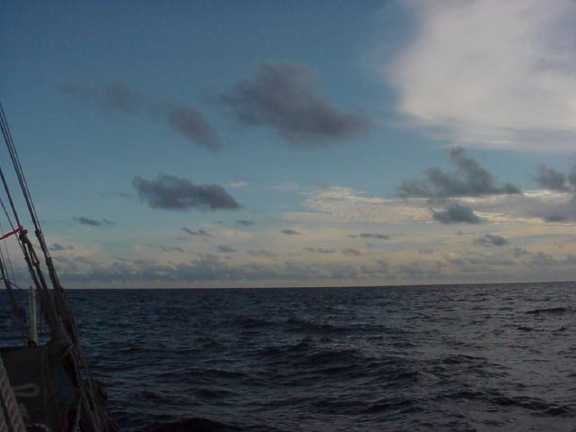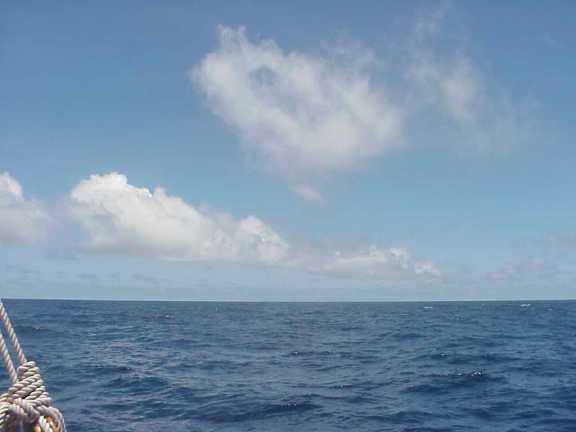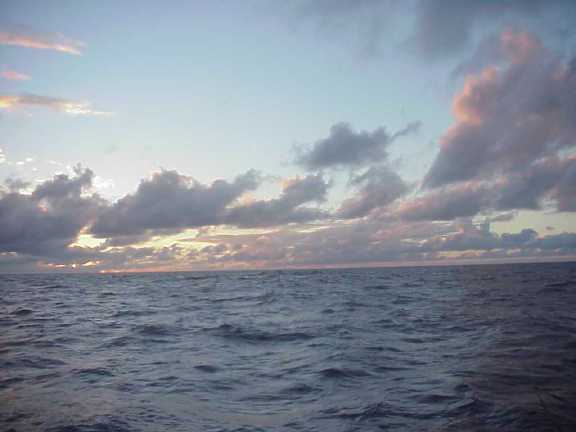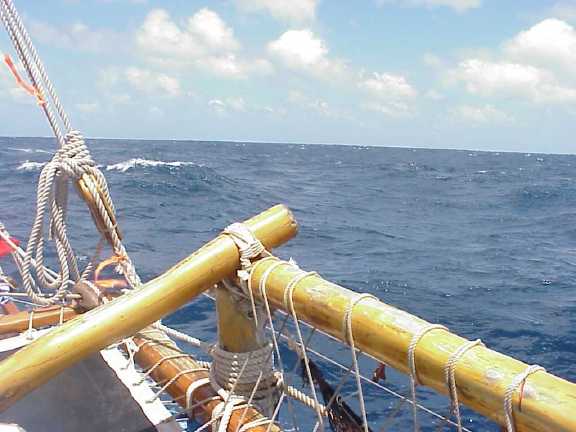Predicting Weather: Reading Clouds and Sea States
Nainoa Thompson
During Hokule'a's voyage from Tahiti to Hawai'i in February, 2000, documentor Sam Low photographed clouds and sea states and recorded navigator Nainoa Thompson's readings of them.
Sunrise, February 11, 2000; 6 days out of Tahiti
View from Hokule‘a’s beam--towering cumulus clouds:

"A Navigator always looks for signs of weather at sunset and sunrise," Nainoa says. "Generally, at sunrise and sunset you try to predict the weather for the next 12 hours. Today I see strong evidence in the clouds of a change in the weather from what we have experienced in the last 2 to 3 days. Looking to the east--off the beam of the canoe (this is picture 1) I see various complicated towering high cloud masses, which are the remnants of the squalls that we went through last night. Yesterday and the day before I looked out and saw actual squalls there--today there are no squalls evident. You can't really predict the weather, as Mau taught me, from a single snapshot like this. You have to observe changes over time. In this case, I see a change from seeing squalls off the starboard yesterday to this view today where there are no active squalls. The wind definitely feels stronger today and I can see wind wavelets on the surface of the ocean. The wind is also coming from the normal direction of the SE trades, so I can presume that the trades are reasserting themselves."
View towards the bow of the canoe from roughly dead ahead to 45 degrees off the bow:

"I see a lot of low level cumulus clouds ahead of us in the direction we are moving. There are no indications of any squalls in those clouds so I think I can predict we are approaching an area of clean flowing wind--trades from the SE--which will be steady. That is quite different than the variable winds we have been experiencing. So, for the next 12 hours, I believe that the wind will remain steady from the SE at a fairly constant speed, maybe 10 knots, so we will be able to sail N today."
"Every time I attempt to predict the weather or sail on this canoe I am constantly reminded of how smart our ancestors were. My understanding of nature is feeble compared to theirs. We can have today only a glimpse into their world--into the strength and courage that made them the greatest navigators and explorers on earth. We sail in comfort with foul weather gear to protect us on a canoe partly made of modern materials, with all kinds of safety devices on board. They had none of that. They were attuned intimately to nature in a way that we cannot be. At best, our voyages are just beginning to give us a glimpse into their world."
Feb. 14, 2000; 9 days out of Tahiti
"Mau taught me to call clouds that look like this "the road to the wind." Imagine at the far horizon there is a factory producing the clouds and, like smoke from a haystack, they follow the wind. This road indicates the wind is coming from the horizon. and because the road is straight, the wind is steady. If you see the road curve--it means that the wind direction will change and the way it curves will tell you the new direction. It is interesting to me that meteorologists call this kind of phenomenon "cloud streets', pretty close to Mau's term "Road of the Wind."

Feb. 15, 2000; 10 days out of Tahiti
Nainoa's view of the sea at sunrise, and what he sees in the shape of the clouds:

"The sky where the sun is rising is very clear--I don't see any smoke (which is caused by strong winds stirring salt into the atmosphere)--so I think the winds will be relatively light today.
"Ahead of us, I see two squalls, but there are no squalls beyond them so we should have good weather once we pass through them."


Feb. 20, 2000; 15 days out of Tahiti
Weather Analysis: Normal trade wind clouds and sea state on February 20, 2000. "On the horizon you see what we call zone -based trade wind cumulus clouds. There is little vertical development, meaning no high clouds, and no squalls are visible. These clouds suggest to me a stable weather pattern. The wind is clean and predictable, blowing 20-25 knots. I judge the wind speed by the feel of the wind against my body, also by the fact there are a lot of white caps and wind streaks along the ocean surface, also the size of the swells which are about ten feet high. (On Feb. 20 the wind blew from the NE, forcing us to steer too far to the west; since then the wind has shifted more easterly allowing us to head north.)

